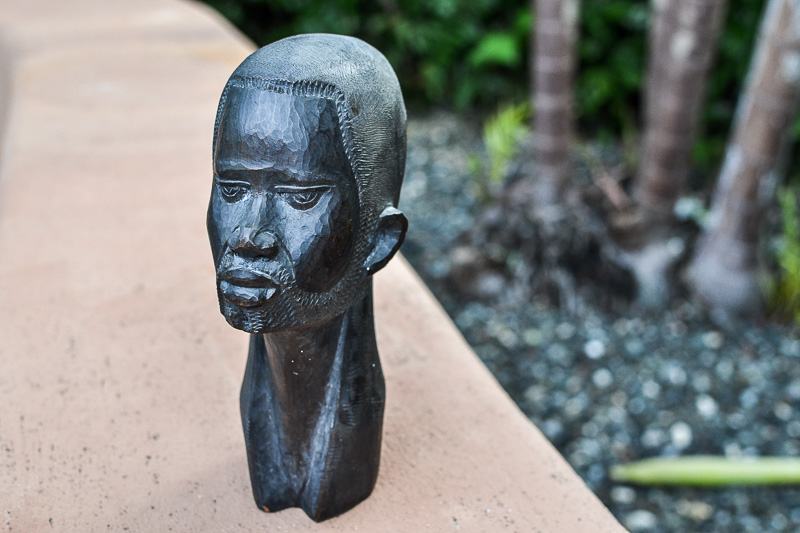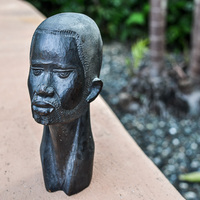Common name: African blackwood
Other common names: African ebony, Chinese blackwood, Mozambique ebony, Senaar ebony, Senegal ebony, Sudan ebony
Description
African blackwood originates from dry parts of tropical and subtropical Africa, its natural range extending from Senegal to South Sudan and from Ethiopia, through Kenya, to southern Africa.
It is either a multi-trunked shrub or a single-trunked tree 5 to 10 m (16 to 33 ft) tall, occasionally reaching up to 12 m (40 ft) under optimal conditions and develops an irregular or rounded crown of short, twisted branches armed with sharp spines. The bark is pale grey to yellow-brown, smooth on young trees, becoming flaking with age.
The leaves are feathery, comprised of up to twelve dull green, blunt oval leaflets arranged in near opposite pairs along the length. These fall to the ground in the dry season, leaving the branches bare until new growth returns in the rainy season.
The flowers are small, white, sweetly fragrant and held in branched clusters arising at nodules along the branches. They come into bloom at the start of the rainy season, coinciding with new leaf growth. They are soon followed by thin, papery seedpods up to 7 cm (2.8 in) long, turning grey at maturity, about six to eight months after flowering.
Use
African blackwood produces a dense timber highly prized for its rich colour though can be highly variable in its form and very slow-growing, needing seventy years or more to reach timber-harvesting size.
It is a heavy wood, averaging out at around 1200 kg per cubic meter (75 lbs per cubic ft), and has high natural resistance to rot, decay and wood-boring insect. This classes it as a durable wood, suitable for all types of construction. However, the logs are small in diameter, yielding only a limited amount of small planks. The heartwood is dark purple-brown with black streaks, contrasting strongly with the creamy-yellow sapwood.
The almost black heartwood is highly prized in carving, general woodcraft and turnery, particularly for making high-quality musical instruments, including piano keys and woodwind instruments such as clarinets and flutes.
Under threat from over-harvesting for its wood, it is a species in need of conservation and has been recorded as a near-threatened species by the International Union for Conservation of Nature (IUCN).

Bust carved from African blackwood
Climate
Grows naturally in sub-humid subtropical and tropical lowland to mid-elevation climates, generally grassland or savanna areas with annual lows of 17 to 24°C, annual highs of 28 to 37°C, annual rainfall of 700 to 1200 mm, and a dry season of 4 to 8 months.
Growing
New plants are usually grown from suckers, cuttings or seed, which germinate readily but only remain viable for a few months.
Performs best on free-draining clay, loam, sand or stony soil of a moderately acid to neutral nature, generally with a pH of 5.5 to 7.5, and on sites with full sun exposure.
The roots are far-reaching and can fix nitrogen from the air in the soil, giving it the ability to thrive on nutrient-poor soils, as well as withstand long periods of drought.
Problem features
Natural regeneration is by root suckers and seed, which are designed for wind dispersal and germinate readily. It is introduced in Australia, India and other countries and is assessed as a high weed risk species for Hawaii by the Hawaii Pacific Weed Risk Assessment (HPWRA) project.
Exposure to the sawdust causes allergic dermatitis in some people.
Where it grows
References
Books
-
C.A.B. International 2013, The CABI encyclopedia of forest trees, CABI Publishing, Wallingford, Oxfordshire
-
Chudnoff, M. 1984, Tropical timbers of the world, Forest Service, U.S. Department of Agriculture (USDA), Washington, D.C.
-
Dharani, N. 2011, Field guide to common trees & shrubs of East Africa, 2nd ed., Struik Nature Publishing, Cape Town
-
Hines, D. A., & Eckman, K. 1993, Indigenous multipurpose trees of Tanzania: uses and economic benefits for people, Cultural Survival Canada
-
Lemmens, R.H.M.J., Louppe, D. & Oteng-Amoako, A.A. (eds). PROTA, Plant Resources of Tropical Africa, Volume 7(1) : Timbers 1, PROTA Foundation, Backhuys Publishers, Leiden
-
National Research Council (Board on Science and Technology for International Development) 1979, Tropical legumes : resources for the future, The National Academies Press, Washington D. C.
-
Porter, T. 2012, Wood : identification & use, Compact edition, Guild of Master Craftsman Publications, Lewes, East Sussex
-
Randall, R. P. 2002, A global compendium of weeds, R.G. and F.J. Richardson Press, Melbourne
-
Scheffer, T. C & Morrell, J. J. 1998, Natural durability of wood : a worldwide checklist of species, Forest Research Laboratory, Oregon State University, Corvallis, Oregon
-
Tatken, R. L., & C. A. Browning 1987, Health effects of exposure to wood dust: A summary of the literature. No. PB-87-218251/XAB, National Institute for Occupational Safety and Health, Cincinnati, Ohio



